Lava Xolo X900 Review - The First Intel Medfield Phone
by Brian Klug on April 25, 2012 6:00 AM ESTGPU Performance - GLBenchmark 2.1
While Intel's Atom core is a newcomer to Android, the PowerVR SGX 540 used in Medfield's SoC has been around the block quite a bit. Most recently, Samsung's Galaxy Nexus used an OMAP 4 that features the same SGX 540 GPU. The GPU clock is a bit higher than we're used to at 400MHz (vs 304MHz for the Galaxy Nexus), but otherwise the design and its performance are both known quantities.
We start with GLBenchmark, one of the better Android GPU tests on the market today. There are two benchmarks, Egypt and Pro, and each is run in two modes: native screen resolution and offscreen (vsync disabled) at 720p. The latter is more useful for apples to apples comparisons as everything is rendering the same number of pixels, whereas performance in the onscreen tests is determined by the screen resolution of the device along with the performance of its GPU.
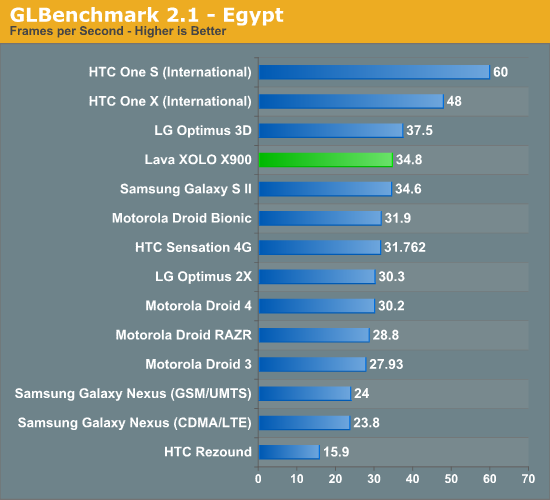
The X900 falls in just behind the Optimus 3D, which shares the same GPU but is running at a lower resolution. All things considered, the X900 does reasonably well here but it's definitely not leading the pack.
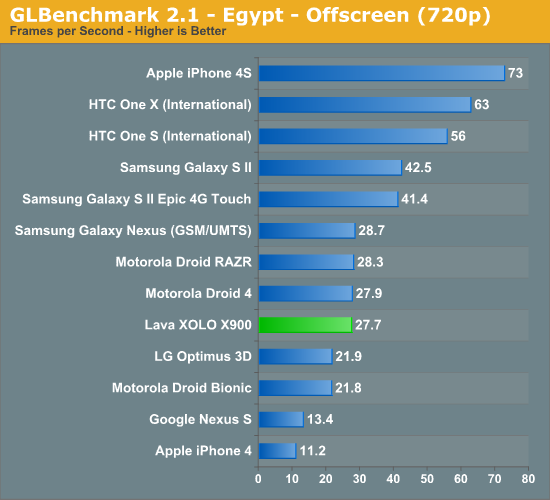
At the same display resolution and without any vsync limits, the X900 falls significantly behind the cream of the crop. Despite the GPU clock advantage, Medfield is no faster than OMAP 4 in the Galaxy Nexus here which is a bit perplexing. We're either bumping into a memory bandwidth limit or some other CPU/driver limitation. Either way, Intel definitely needs a faster GPU. We'll get it but not until early next year with the 544MP2 in the Atom Z2580.
The Pro results actually show us more of what we expected to see:
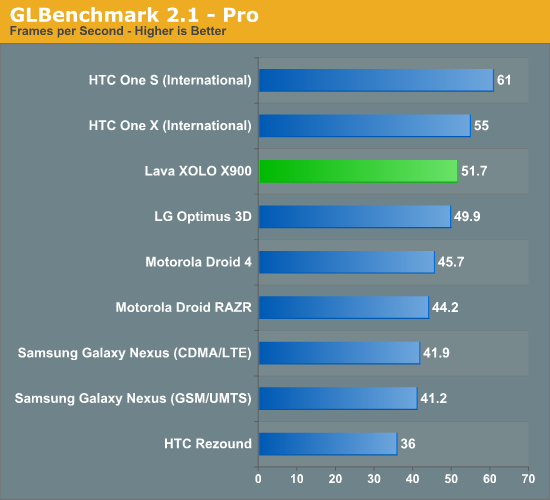
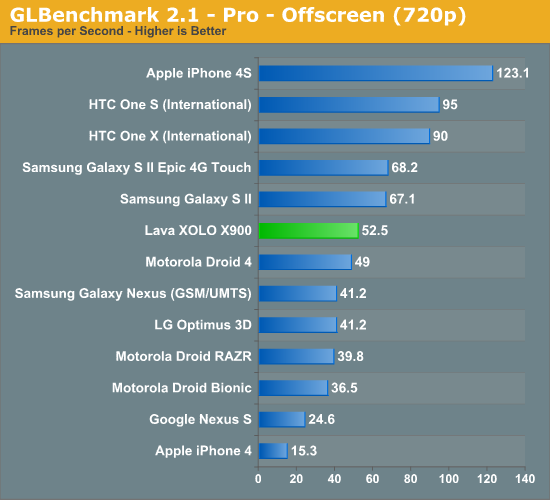
The offscreen tests give the Medfield based X900 a 25% advantage over the Galaxy Nexus, which makes sense. The Droid 4 is closer than that, despite also using the same GPU.
Basemark ES 2.0 V1
Rightware's Basemark ES 2.0 V1 is an aging GPU test that tends to favor Qualcomm's Adreno GPUs above almost all others. The Imagination Technologies based GPUs, such as the SGX 540 used in Medfield (as well as NVIDIA's Tegra GPU) don't fare as well here. Intel's GPU clock advantage does show up a little bit in these tests, making it the fastest PowerVR SGX based offering here:

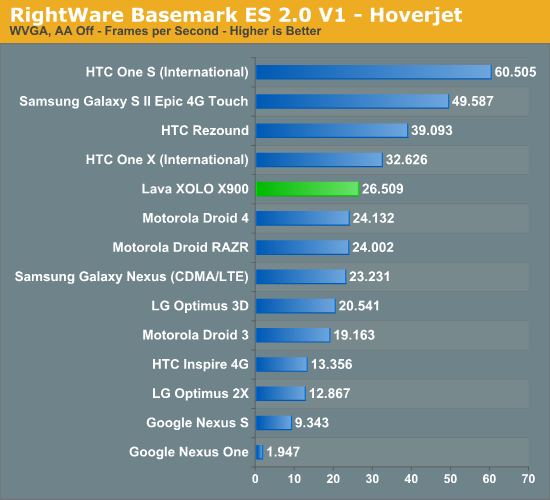










106 Comments
View All Comments
diulaylomochohai - Thursday, April 26, 2012 - link
Where are the numbers for HTC 1X and 1S??? Let see how much INTC is off from latest and greatest from NVDA and QCOM???dwade123 - Friday, April 27, 2012 - link
Intel proves x86 can compete. With Intel's engineering and manufacturing advantages, Intel may soon surpass ARM in just about everything in the future. I still remember those who thinks ARM's transition to desktop is a threat to the entirety of Intel. Nope. It's the other way around. Intel is invading the low wattage CPU arena. Hate them or love them. The future is Intel.jwcalla - Friday, April 27, 2012 - link
I lol'd.jwcalla - Friday, April 27, 2012 - link
Apple just crapped out $12 billion in pure profit in just the last quarter. That's over 4x the profit that Intel saw, and Apple had almost 4x as much total revenue as Intel.The iCraze is in full song and Android is right up there with them. The masses don't care about x86 on a smartphone. And they're not going to. They want the iShiny. Only the dinosaurs that are hooked into these mythical "necessary" legacy x86 mobile apps are going to care about an Intel phone or tablet. And they're going to want them sporting a turbo button and USB-powered 5.25" floppy drive.
pheadland - Friday, April 27, 2012 - link
Small correction: I know Samsung says the GS2 only takes 32GB SD cards, but numerous people, including me, have 64GB SDXC cards working just fine in their GS2s (and many other Android phones).This trend to omit SD expansion and provide only 16GB built-in is puzzling and annoying. I have around 40GB of music. TV shows and movies can run multiple GB each. Streaming just doesn't cut it in rural areas or on planes.
phoenix_rizzen - Wednesday, May 2, 2012 - link
Have you put more than 32 GB of data on that 64 GB card, to make sure it's actually able to use all of it? Just curious, more than anything.Exophase - Friday, April 27, 2012 - link
In the article you say that the translations are taken from Intel's servers in order to avoid the overhead of doing it on the phone. I doubt this is true, because based on Intel's publications the translation in its current state isn't that sophisticated and unless it is very poorly coded there's no way it'd be slower to do it on the device than pull it off the network.I think the real reason they did this is so they can improve the translation quality w/o updating the phones. Part of this could include hand optimizing hot spots or fixing incompatibilities in some of the more problematic games. Maintaining a database of program specific modifications on every phone would not be a good move.
The article had some good information but I'm disappointed in the total lack of attention given to games. In the big list of apps that work fine I could only spot one game. For comparison, S|A tried two games - both worked, but one of them had awful performance. The phone game market is huge right now and it'd be nice to see someone try several - dozens, perhaps? - of games on the unit. But if they don't, the review should at least indicate that it's not focusing on it. With reviews like this it feels like phone gaming is almost completely devalued, which is bizarre given that several GPU benchmarks are performed, and GPU performance benefits little more than gaming.
Of course, the battery life tests also don't address gaming. The iPhone 4S review had at least one gaming test (for something really resource intensive) so it's not like there's zero precedent for it.
The big open questions for Intel putting x86 phones have never been if they can implement competitive GPUs or media blocks or even if they can have very low power consumption when there's low CPU activity. These things are obvious and Intel has already proven themselves on all of these fronts. What people want to know, or at least what I want to know, is what the power consumption is like when the CPU is being heavily accessed. In other words, I want an idea of perf/W. Talk time tests use a negligible amount of CPU. Browser tests use an unknown amount of CPU - it could be literally anything depending on what sites you use and how the idle parameters are tuned. I'd love to see some CPU utilization + frequency graphics during this test. But suffice it to say, if you're trying to simulate the user browser experience it'll consists of small periods of heavy activity while pages are loaded and vast periods of low activity while the user reads what's on the page.
This is totally different from at least a lot of games, where the CPU constantly has to do something. This both increases the average frequency it has to operate in and gives it less time to go from full idle to full activity.
At the very least it'd be nice to see some video playback battery tests. This (ideally) doesn't use much CPU either, and I'm sure Medfield does just fine here, but it's at least an important use case that should be validated. When you're on an airplane I'm sure you won't be using your phone for talking or web browsing.
kuroxp - Monday, May 21, 2012 - link
say sorry! see updates. :Dsjprg2 - Sunday, April 29, 2012 - link
Are all the cell phone makers STUPID? Where is the hands free bluetooth support with caller ID such as the Motorola V750 has? These are supposed to be phone! You can't drive in Califorina with the existing smartphones. They are not legal!derodg - Monday, May 7, 2012 - link
You people are forgetting one very important thing here. This is x86 device! I should in theory be able to run any x86 compatible OS. Which includes Windows 8 that has a touch interface. This means I could dock my phone to a larger display use a keyboard and mouse. Then pick it up an walk out the door and use the same device.And once they get dual-cores in the Atom. Not only can I just buy one app. I can use it on my desktop and mobile device because they both would be the same.